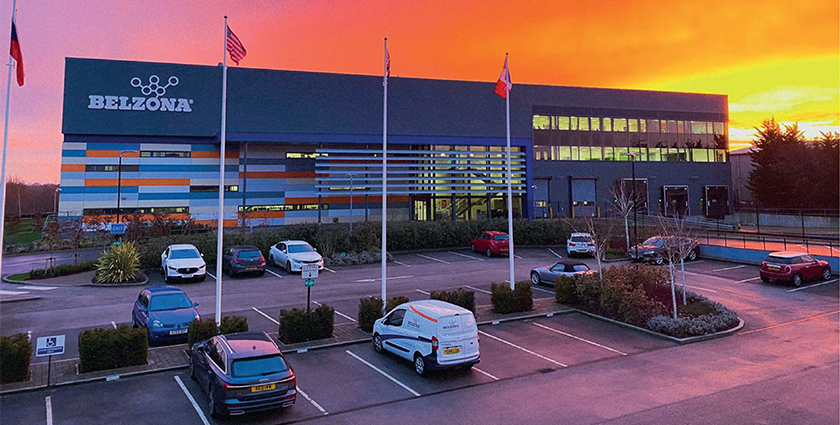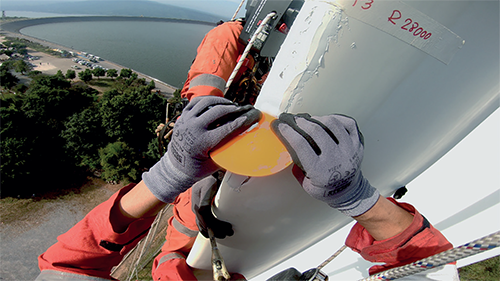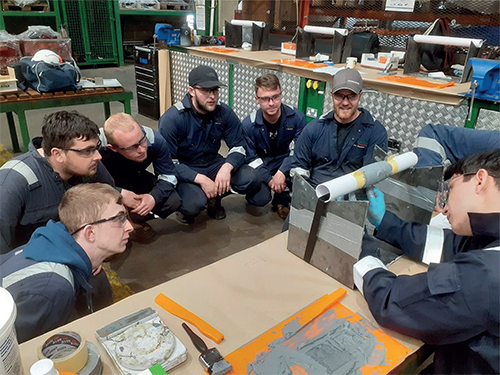
Belzona
Repair, protect, improve
Though not necessarily a household name in the consumer market, Belzona is widely recognized for its advanced polymer technology in myriad industries – oil and gas, marine, renewable energy, waste-to-power, petrochemicals, steel, and wastewater treatment to name just a few. Now, though, it’s turning its attention to plant-based chemicals as a source of sustainable polymer products
Having specialized in combating erosion, corrosion, and chemical attack for 70 years, Belzona has become the go-to provider of innovative, high-performance polymer coating solutions, allowing its industrial partners to repair and protect a wide range of machinery, buildings, and equipment.
Offering us an insight into the chemistry and methodologies employed behind-the-scenes is Jevon Pugh, Research and Development Director at Belzona. “Our core technology is polymer chemistry,” he begins. “In our laboratories, we design, formulate, and manufacture a range of coating solutions, enabling our industrial customers to protect assets that would otherwise suffer from the effects of aggressive service conditions. For instance, slurries and strong chemicals cause abrasion and corrosion as they pass down pipes and through production equipment, and factors such as these as well as elevated temperatures mean that conventional protective coatings won’t survive. Therefore, companies must turn to a high-performance polymer solution to appropriately protect their assets – and that’s where we come in.
“The company was born in 1952 off the back of pioneering zinc-rich corrosion protection technology,” Jevon adds. “It could be applied to all kinds of steel structures, creating a polymer-zinc barrier that would resist aggressive corrosion and protect the integrity of the steel beneath it. Belzona then developed a range of polymer coatings and repair pastes – the original being Super Metal which has been widely copied over the years – for the repair and rebuilding of assets, before then coating and protecting them against any future damage. These metallic pastes can be applied onto a damaged or worn surface in thick layers, allowing it to be reshaped and reformed back to its original profile. The paste then sets rock hard, almost like the steel itself, and brings that original asset back to life.”
Testing capability
Since then, the company has gone on to develop high temperature immersion linings, which are widely used in the oil and gas industry on structures that have to contend with water, steam, oil, sand, and chemicals throughout their processing life. Belzona has also developed composite repair systems made from densely woven structural fabrics made from glass fiber or carbon fiber, that can be used to return strength and fortify compromised pipes or other structures.
“Composite repair is a rapidly growing market,” says Jevon. “For that niche, we have a brand called SuperWrap, which effectively creates a composite pipe that surrounds the original steel pipe. When a steel pipe is damaged or corroded, perhaps through chemical attack, then it will ultimately lose strength and can, in the worst cases, leak. This can result in entire plants or facilities being shut down for extensive periods of time. This is a major issue, and one that could result in millions of dollars being lost every day. To protect our customer’s assets, we developed a solution that restores the integrity of that pipe via a composite wrap; bringing back its original strength and improving it, through increased rigidity, corrosion resistance and chemical resistance.”
To create market-leading products of this kind and supply them to global industries, a lot of research and development (R&D) must take place. To that end, Belzona has two R&D facilities – one in Harrogate, UK and the other in Miami, US. Both of which also possess manufacturing capabilities, which enables the company to not only design, formulate, and test its polymer solutions, but also produce them on a commercial scale.
“Going back to my chemist roots, it’s wonderful to walk through our facilities and follow the journey of our products,” explains Jevon. “Our chemists are involved at all stages, through design, development and manufacture. You can see people working at the metaphorical drawing board all the way through to those supervising the first batch of a new polymer solution being made. As part of the development and manufacturing process, we focus on sourcing materials that are commercially available, can provide the requisite performance, are of the highest quality, and which are as safe and sustainable as possible. By working with different chemical manufacturers, who create the building blocks of these solutions, we’re able to apply our scientific knowledge and expertise, creating an easily appliable, safe, high-performance polymer product.
“A key step in the development process is testing,” he continues. “We have fully equipped testing laboratories at our UK and US sites, allowing us to study and characterize the performance of our products, and thereby optimize our formulations. We put every solution through an extensive programme of testing – which is defined by the intended end-use for the product. For example, abrasion resistance testing for a slurry pump lining, or weathering testing for an exterior anti-corrosion coating – the majority of which is carried out in-house. It is Belzona’s investment in this testing capability which sets us apart from most competitors.”
 Sustainable solutions
Sustainable solutions
While the UK and US serve as the two core bases for Belzona’s global operations, its footprint expands into further territories. It also has corporate presences in the form of training and support centers in Thailand, Canada and China, and a global network of distributors in over 120 countries. Increasingly, the popular polymer coatings manufacturer is turning its attention to expanding its portfolio of sustainable solutions.
“The latest step in Belzona’s journey is its work in the renewable energy sector,” Jevon details. “We talked earlier about repairing assets instead of replacing them. That’s always been fundamental to the Belzona philosophy. Originally, though, that philosophy would’ve been primarily driven by cost: it’s generally cheaper to repair an asset than to buy a new one, so the customer saves money. To this day, that logic remains. However, there’s another, increasingly important, aspect in play today: sustainability. The planet is moving away from fossil fuels to more renewable sources of energy, and looking for new ways to reduce waste and improve efficiency, and Belzona intends to be a part of that journey.
“For example, we’re now heavily involved in the maintenance and repair of wind turbines,” he explains. “One key challenge that wind turbines face is the gradual erosion of the leading edge of their blades, which wear down over time due to the combination of high velocity and rain or dust impacts that each individual blade will experience. To combat this and improve efficiency, thereby generating more clean electricity, we applied our knowledge of abrasion resistant coatings from other industries to create a polymer system that can be used to restore the original profile of the blade, and then protect it from future erosion – all in situ. In practical terms, that means the asset doesn’t have to be decommissioned and dismantled; instead, a contractor can repair and protect the blade on-site with a suite of Belzona products and restore the integrity and efficiency of the turbine, eradicating the possibility of having to replace the asset. In fact, we’re currently finalising a second-generation leading edge protection coating, which we look forward to presenting with other Belzona solutions at a wind exhibition in Hamburg later this year, as well as delivering to our customers in due course.”
Problem solvers
Another fascinating part of Belzona’s sustainability drive is its investigation into the efficacy of plant-based polymer solutions. As Jevon informs us, one negative aspect of working with polymers is that the chemical building blocks used throughout the performance coatings sector are derived from oil, which carries an environmental impact. However, that’s starting to change. “More recently, we’ve been exploring the development of high-performance polymer solutions using feed stocks derived from a renewable carbon source: plants,” he observes. “Though plant-based chemicals have been available for low-performance solutions, including decorative paints, for some time, it has not previously been possible in the heavy industry market.
“But, more and more, chemical manufacturers are recognizing the need for plant-derived polymers,” Jevon notes. “And it’s now possible to achieve very similar performance to oil-derived equivalents. At Belzona, we’re really excited about this ongoing change within the chemical industry, and as a down-stream producer, we intend to pull together with manufacturers, encouraging the adoption of more renewable-carbon solutions that don’t compromise on quality or performance. It’s a win for our business, our customers, and the environment.”
Going forward, that focus on sustainability and conservation of the planet’s resources is informing much of Belzona’s future endeavors. For example, the company’s engineering and chemist teams will be continuing to optimize systems for containing SF6 leaks (sulfur hexafluoride), a gas commonly used in electrical switch gear and power transmission equipment due to its insulating qualities. As Jevon points out, this greenhouse gas is many thousands of times more damaging than carbon dioxide, so even small leaks must be repaired. “This is a massive problem, and one that we’re really excited to be working on in partnership with industry,” he concludes. “The SF6 project reflects an increasingly important mission being adopted by Belzona: creating products that solve industrial problems in a safe and sustainable way. As we move into the next part of our company’s history, we will continue to fulfil that mission because it makes good business sense, but also because it’s what our customers and staff want.”
Belzona
www.belzona.com
Products: Polymer coatings